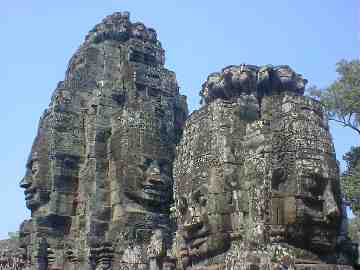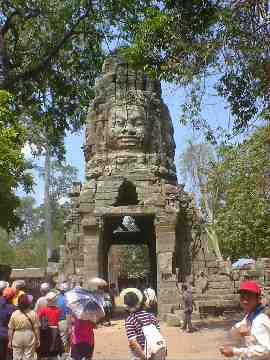|
The second day, we hired motorbikes to take us to the sites around the main Angkor complex, which lie closer to Siem
Reap. It was so much more fun than driving in the car had been the day before. The sensation of speed, and
feeling the sun on my back and the breeze in my hair, and of being close to what I was seeing, whether it was the ruins of
buildings, or the natural scenery, more than made up for the lack of air conditioning.
In the morning, we visited Ta Prohm. A miscommunication with our moto drivers accidentally split our group.
M. ended up at one entrance, and F&S and I ended up on the opposite side. While we were waiting to see if M. would catch
up with us, we were accosted by a rowdy, persistent bunch of children, sons of the vendors who were working near the entrance.
They all had their little mementos to sell, and they all were eager to talk to us. I eventually persuaded them to quiet
down long enough to take this picture, which captures the cute, but not the energy. They were really engaging.
Finally, we figured out what had happened to M., and we set off to see if we could meet her halfway.
Ta Prohm is absolutely stunning. It's the one site at Angkor left largely as it was when it was discovered by Europeans
in the 19th century. The jungle has so deeply invaded the structure that preservations were afraid to remove the trees
and vines, for fear of causing more damage to the buildings that remain. We were greeted by the sight of massive trees
stretching up from the roofs of ruined buildings, spilling their twining roots over the walls and floors, and into the plazas.
The trees looming overhead kept the sun off, and the chatter of the visitors from becoming too intrusive. In one sandy
plaza, an old man crept along in a crouch, rhythmically surrounding himself with clouds of dust swept up with a short-handled
broom. It seemed like it must be a meditative or a penitent practice, because it certainly didn't look like a practical
activity. But he soldiered on, stirring up the dust, only to have it settle again behind him, and murmuring polite greetings
to the passing tourists.
We left Ta Prohm, and braved the midday sun to visit Angkor Thom, which was the city of Angkor. (Angkor Wat was
the temple complex for the city, but because it's the most famous attraction, people generally refer to all the ruins in the
area as "Angkor Wat.") The heat was brutal, but wasn't too hard to ignore it as we examined the statues as bas-reliefs
of the Elephant Terrace (guess what the decorative theme was) and the Terrace of the Leper King. We were assisted by
three young boys who, in about 10 years, will be perfectly capable of putting the current generation of tour guides out of
business.
The jewel of Angkor Thom is The Bayon, a massive temple with an intricately carved bas-relief wall surrounding dozens
upon dozens of thick, intricately carved towers. Each square tower bears four huge, heavy-lidded faces, quietly smiling
to the north, south, east, and west. We circled the bas-relief wall, admiring the intricacy of the carvings, and then
climbed up into the temple to sit in the shade, where we discussed whether the subtle variations in the expressions of the
monumental faces around us were intentionally planned by the sculptors or simply the result of the play of light and shadow
across their features.

|
| The Bayon |

|
| Not just at The Bayon - "the smile of Angkor" at Ta Prohm |
|